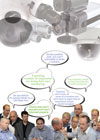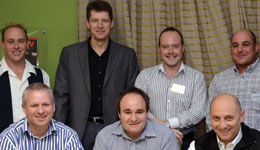

Hi-Tech Security Solutions recently gathered a few industry experts together to talk about the growing field of remote monitoring. Last year’s round-table was such a success we had to extend the coverage over two issues. This year looks much the same so we can assume it is a growing, profitable market for many of its practitioners, as well as a service more companies are looking for.
This year we gathered a mixture of people together, from those supplying technology to remote monitoring sites, those operating sites and those with experience in building these operations. The goal: discussing the state of the remote monitoring market and ascertaining what the latest trends and issues are facing those in the market.

Starting the ball rolling, the attendees were asked to give an indication of what was happening in the remote monitoring market from their perspective.
Philip Smerkovitz from TeleEye (South Africa) said he has seen that remote monitoring, on the one hand, is a service offered by security companies in support of their other existing services, such as alarm verification services. Other companies, he says, seem to have made remote monitoring an integral part of their total solution. However, he also sees a growing number of corporates doing their own monitoring and running their own control rooms.

This is more prevalent in sensitive industries like banking and mining where the companies have the infrastructures to support a remote monitoring operation.
TeleEye SA distributes the range of TeleEye remote monitoring products throughout Africa. The company has recently been appointed as the African distributors for Flir, where Smerkovitz sees a natural fit between the use of thermal cameras and off-site monitoring.
Geoff Schapiro from SSG adds that as a service provider, he has seen a move towards off-site remote video monitoring, however, he believes the industry needs to first educate the market properly as to what it can expect from this type of service. SSG is an integrated service provider, offering guards, tactical officers, investigators, control room monitoring and other divisions. The company has been doing off-site monitoring over the past six years.

The definition of a remote monitoring service varies according to whoever is offering the service. Some offer live, proactive guarding via video feeds, others offer alarm verification services and others simply offer an infrastructure that allows for limited video monitoring over non-typical and not always fully functional communications mechanisms such as 3G or ADSL. Some offer a full service including armed response while others are more of a modern burglar alarm service. When clients understand the options open to them, they will be able to make better decisions as to what they need and what they realistically can expect.
Many of today’s remote monitoring services are not offered by the traditional guarding companies, but by system integrators that have built sophisticated control room scenarios they can offer to clients, concurs Stanley Security Solutions’ Tim Timmins. He recently launched the Stanley Building Management Systems division, concentrating on system integration and building management. The company has its own control room in Cape Town from where it monitors several customers. It plans to launch a second control room in Johannesburg.

There are really two sides to the remote monitoring question, according to MJ Oosthuizen from Norbain SA. On the one hand, there is live remote monitoring and management, and on the other, there is video alarm verification. “There is a big difference between the two because to monitor video remotely, you can do it over various mediums, but if you purely want to do remote alarm verification, it is a different type of application because it is verifying the video and responding to it,” he explains.

Norbain South Africa is a value added distribution house that assists customers with design and consulting work. Oosthuizen adds that this includes the setting up control rooms, although Norbain does not own or operate any.
As in other fields that were previously the exclusive turf of security operators, Graphic Image Technology’s (GIT) Mark Chertkow, says he sees remote monitoring becoming an operational tool as well as a security service. He provides the example of a jewellery store where the owner is able to ensure staff attends to customers immediately. One worker was reading the paper and ignoring customers until the boss saw him over the store CCTV service and telephoned him to ask what was going on.

“So in terms of the value proposition, there is probably more value in owners of businesses, certainly in smaller businesses, being able to manage what their staff are doing,” he says.
GIT has a 20-year track record in the broadcast and security video space. It specialises in moving video over networks, especially remote links using GPRS and GSM technologies.
Dusty van den Berg from Daytona Electronics supports this view, saying his company is an integrator that also runs its own video monitoring control room using products from the suppliers above.

Beyond alarms
Remote monitoring has been with us for years, but it is only in the past few years that companies have migrated past the alarm and armed response service so common in South Africa. Today many companies add cameras to their services to either support or replace their guarding personnel.
This in itself can be a problem within a solution, especially for uneducated clients. To save money, some service providers remove guards and replace them with cameras that are monitored from a remote control room, hoping that the remote monitoring will keep their premises safe. The main advantage is that if an alarm is raised by sensors or intelligent software within the camera, a visual verification can be done before armed response units are dispatched or the police called.
The catch is that cameras cannot cover all areas of a location and cannot react to certain signs that an experienced human would recognise. Of course, on the positive side, you cannot intimidate or bribe a camera. In addition, Schapiro notes that SSG has had instances where patrolling guards were continually setting off alarms triggered by cameras with motion detection as they moved about their rounds.
This type of problem is often the result of a slapdash approach to installing cameras, often focusing more on internal areas than vulnerable points in the perimeter. Schapiro says there is a science in getting the right balance between the right placement of cameras and the number and placement of guards. He believes both technology and manpower are still necessary for an effective solution.
Smerkovitz notes that the remote monitoring system should be designed to facilitate both management and video alarm verification. “Typically your management side would be going to the same video response centre that might be tasked to do point of sale functionality or management functionality, checking weigh bridges and so on. The video alarm verification should be an early warning system and not a reactive system. You design your systems in such a way that you move your detection out to the perimeter, exactly as a guard would be and you can afford false alarms because you are verifying each alarm before reacting.
“In other words, you should be alerting your control room operator that someone is at the fence, before they enter the premises. The moment they start becoming a threat the operator is already on the case and escalating the problem.”
Why this does not always work, he says, is because some companies are trying to add a few cameras to their existing internal alarm systems, which generally only react too late – such as when someone is already inside the building. Again, it is a case of understanding where to place and aim cameras as well as which cameras and communications options to select.
Van Den Berg reverts to a previous argument about education. “The biggest problem I am running into in the market at the moment is clients that are not educated and are not informed properly. I was at a client recently that told me he has off-site monitoring, but he was still robbed. When I gave him a breakdown of exactly how we do things in our control room, he said “that is not off-site monitoring. Off-site monitoring is somebody sitting in a control room permanently watching the cameras and actually looking for incidents”. The biggest need to focus on is getting clients educated as to what off-site monitoring is.”
Daytona divides its control room into three sectors. The first sector is for alarm verification, where the company protects the perimeters and key areas within the clients buildings, making use of motion detectors and camera etc, to send alarms to the OSVM control room where the controller will verification the alarm dial back and invoke the relevant procedures.
The second sector is production monitoring where the company’s operators are permanently connected to a site during the day and or night to monitor activity from a production point of view – are the systems working, are employees wearing safety gear etc.
The third sector is post investigations, where the company analyses historical footage to resolve customer issues. For example, a customer may say that his company lost a specific stock item the previous month. Daytona’s staff then analyse footage for that time period to identify perpetrators or pick up suspicious activity related to the reported problem.
Timmins goes a step further, noting that using the audio capabilities in many cameras allows remote operators to challenge people to ascertain who they are and if they have business in the areas they are in. Added to that, incorporating building management information in remote scenarios adds another level of value to the service. Alarms and notifications of faulty air conditioners, generators and so forth can be logged and marked for maintenance as they happen quite easily within the same security control room.

Educating the customer
The issue of customer education and expectations is one that was often repeated during the round-table. Less ethical operators often promise undeliverable solutions or agree to do anything clients want, regardless of how necessary or viable they are.
Those that opt for live monitoring often do not realise the limited time an operator can actually concentrate on what is happening on screen. Here Chertkow advises a combination of technology and manpower in which the technology raises an alarm that is verified by an operator. The key, he says, “is managing customer expectations.”
Oosthuizen adds that the industry is not simply selling products anymore, but solutions incorporating advanced technology. The customer needs to understand what the technology you are selling is really capable of doing.
As we all know, the security industry is notorious for being cutthroat. Schapiro says many service providers and installers compete on price alone because customers do not understand what they are buying and even why. “They do not understand the system or the back-end infrastructure you are putting in place, they probably just want to tick a box off in their head. From our point of view we have taken a view that we would rather educate clients and lose that sale, but at least there is one more educated person out there because if we can start getting more customers educated in the correct way, eventually we will have that tipping point and people will understand that there is the correct way and the incorrect way of doing things.”
Developing the standard operating procedures for a site with the client is an effective way to ensure the solution developed delivers what the client wants, says ADT’s Neville Wilken. Working together will help both sides to understand the real issues being faced and the reasons for specific solutions.
However, he adds that if clients are not prepared to implement the solution the service provider suggests, it might be better to walk away than to compromise on technology or quality. “These types of deals may end up biting you at the end of the day, especially if customers expect miraculous performance from best-effort communications services.”
Infrastructure concerns
Anyone reading the ICT media these days could be excused for believing that South Africa has an amazing broadband infrastructure that will manage to broadcast all the high-definition video streams from your cameras. The reality is somewhat different.
The country has a vastly improved communications infrastructure, but these are best-effort systems that are renowned for poor performance, especially when it comes to video, and high costs. The infrastructure solution you choose depends on geographics, what is available where you are, says Smerkovitz.
“We can do very good monitoring with a simple ADSL line, a 512 Kbps uplink is more than sufficient for video alarm verification of a 16 channel site, depending on the contention of alarms and how many cameras,” he says. “Generally you look for a primary source of communication that depends on what you are going to need.”
He continues that the first step is to see if the medium you have in mind, such as ADSL for example, is a reliable medium in that area. Then you need to look at what there is for a fail over option. Most often wireless technology in the form of cellular communication is the fail over solution, but care needs to be taken in terms of the costs. If your ADSL line is down for three weeks, you are going to have a serious cellular bill and it could be more cost-effective to put a guard at the site.
Schapiro suggests microwave as a reliable alternate solution, but warns you need line of sight.
Chertkow adds that compression technologies have also played a big role in making it easier to get decent camera streams down on cellular technology. He can deliver 16 camera feeds on a 128 Kbps line, which is achievable with today’s infrastructure – but the customer and installer need to carefully match what they require with the technology that works best for them.
In the control room
Whenever people think about remote monitoring, the popular misconception is that the success of the service depends primarily on the technology chosen. The reality is that the operators in the control room are a crucial part of the success of a remote monitoring venture. Simply taking security guards and putting them in front of a screen will not do the job.
Timmins says the primary prerequisite for the job of an operator is the right aptitude. We are looking at appointing a number of people with disabilities to our control room in Cape Town as surveys have stated that they have the best concentration levels.
Smerkovitz adds that even though there may be more technology involved in a remote monitoring service, at the end of the day, there is still a decision to be made and this is a human decision. Wrong decisions from low-quality staff will end up costing the service provider money. This is why an experienced administrator is also a must-have in every control room. Experience can discern a homeless wanderer from a clever criminal.
“You are defeating the whole purpose of the exercise if you put entry-level staff in your control rooms”, Van Den Berg says. Not only are you risking your revenue stream, your clients are also at risk and so is your reputation. Daytona insists on some IT skills since operators work on computers; and it trains its operators to observe body language. “We had a controller about two years ago who saw the guards sitting in the guardroom on site and noticed that they were all sitting ‘differently’. When he telephoned them he realised they were not the guards, but criminals in the guards’ uniforms.”
He therefore disagrees with Smerkovitz, saying that the operator is the most important person in the equation as he/she has to identify an incident and escalate it or ignore it.
Similarly, Wilken advises that the control room itself needs to be designed to stimulate people. In a previous issue of Hi-Tech Security Solutions, Dr Craig Donald noted that most control rooms are quiet dark places, which are perfect for encouraging sleep.
Looking ahead
Assuming the operators stay awake, one remote monitoring service that is expected to provide a healthy growth stream in the medium term is the production monitoring and building management aspect, which we will deal with in more depth in a future issue. From the perspectives of the round-table attendees, the future looks bright with new technologies, new areas of business and not a little expansion. Here are a few of their plans for the coming year.
From value added distribution perspective, Oosthuizen says Norbain will be adding intelligence into the off-site monitoring solutions it sells in the coming year. “The goal is adding value and making the control room smarter.”
Schapiro says he has picked up a trend among customers that they are more inclined to want to deal with “smaller, local, owner managed companies where they know they can go direct to the top and find a solution to the issues they have, as opposed to the large, anonymous international corporations.”
The world of mobility is also starting to make its presence known in this market, not only from using cellular infrastructure to stream video, but in terms of the devices people receive streams on. Chertkow notes that more people are accepting the benefits of being able to view their premises while they are on the road or at home over their smartphones. This is also a way in which false alarms can be avoided and, if the integration is there, alarms can be reset and doors opened remotely by authorised people.
Wilken says the latest technologies are allowing ADT to move into the home automation space, integrating video into the heart of the alarm system. Customers and response centres can now understand exactly what is happening at their premises and react in the appropriate way. The Internet is playing a significant role in these capabilities.
Stanley South Africa is also changing by moving into the systems integration arena at a rapid pace, incorporating building management technologies into its solutions, which are based on open systems.
Daytona Electronics has just purchased new premises and plans on expanding its control room into the new premises. Van Den Berg says it will focus more on live production monitoring this year without neglecting its security services. On a positive note, he says over the past year the SAPS response to emergencies raised by the control room has been exceptional, with the police often arriving at a scene before the armed response companies.
From the perspective of a distributor and manufacture, Smerkovitz expects to see growth in the remote video and alarm verification market as a whole. He is also trying to educate users on the importance of the relationship between the brand manufacturer and the solution partner. “We are encouraging them to work with us and we have structured our business in a way that we have personnel qualified to assist on projects to ensure the delivery is what the customer expects.”
While the security aspect of remote monitoring solutions is certainly still the primary the selling point, it appears this part of the security industry is also being converged – to use an overused term – into the general business operations of companies. The systems installed today are being used beyond the grudge purchase of security, to add value to daily operations and monitor productivity in companies. And this is not a bad thing; it opens the field to new players and technologies and empowers the service providers to gain a stronger foothold in their customers’ businesses. Of course its success depends on the delivery capacities of the service providers, as it does in any other field of business.
| Tel: | +27 11 543 5800 |
| Email: | [email protected] |
| www: | www.technews.co.za |
| Articles: | More information and articles about Technews Publishing (SA Instrumentation & Control) |

© Technews Publishing (Pty) Ltd. | All Rights Reserved.